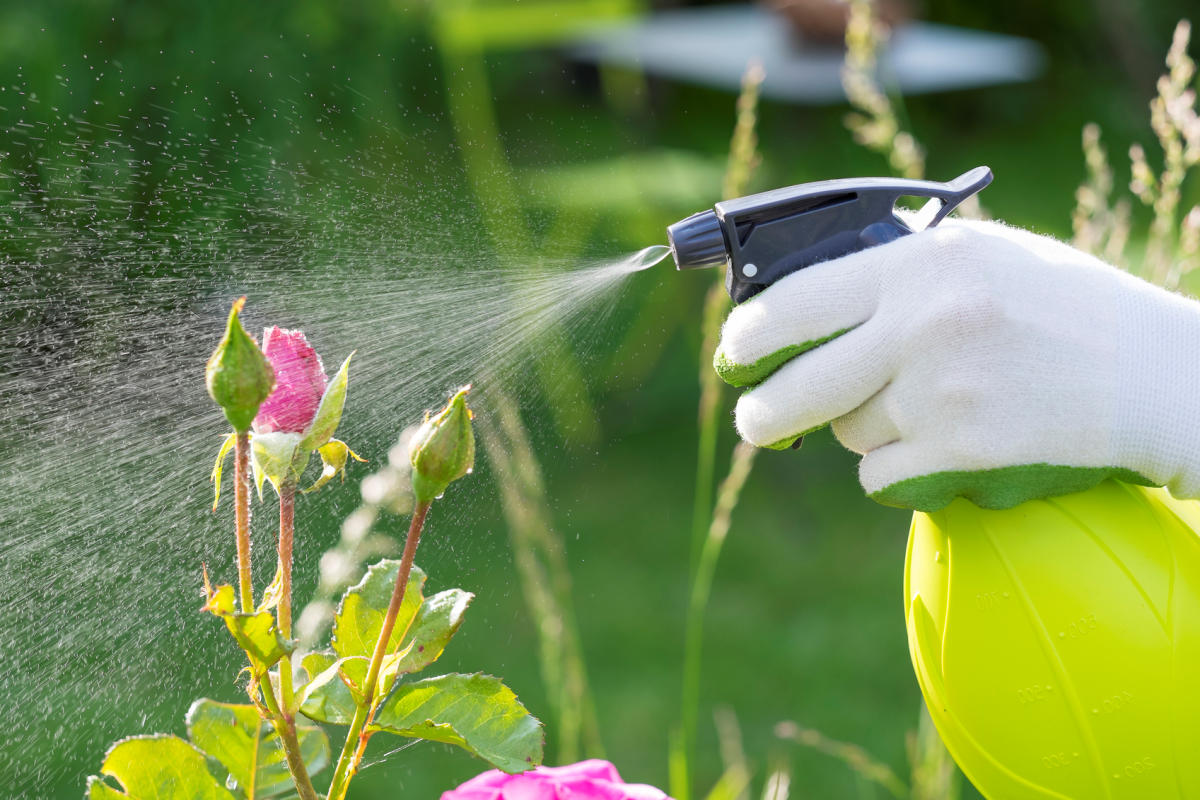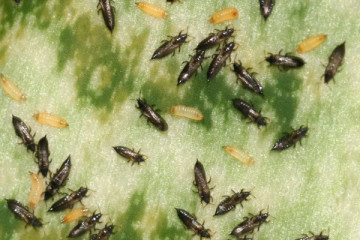Aphids on indoor plants - how to fight at home
Content:
Noticing aphids on plants, they begin to fight pests. Small insects not only visually spoil the flowers, but with uncontrolled reproduction lead to the death of the affected specimen. Plant lovers have a considerable arsenal of tools and effective advice on how to get rid of aphids on indoor flowers at home.
If there is a dangerous aphid on home flowers, how to get rid of pests quickly with your own hands, each plant owner immediately decides after its appearance. Aphids are one of the smallest insects with an oblong body, up to 2-3.8 mm. Black, green, white aphids settle on domestic plants, adapt to different conditions of existence, multiply rapidly. Whole colonies are formed - the female insect lays 70-80 larvae. The young wingless generation matures in 15-18 days and produces offspring. Aphids of the third order are winged and spread to new habitats.
Signs of plant damage by aphids
Insects feed on the sap of tender parts of plants: they pierce leaves, buds, flowers with a proboscis and suck out the liquid.
Under the leaves of the aphid colony
It is important to find and remove aphids at the very beginning of colony development. Getting on a new plant, insects accumulate at the bottom of the leaf. When the colony grows, some of the pests move from the seamy surface of the leaves to the front. More often, the owner of flowers finds a colony in this phase. To prevent the dispersal of aphids, starting in May, houseplants are examined. Pay attention to the condition of the leaves and shoots. When watering, they notice that there are small yellowish spots on the top of the leaf blade. These are traces of aphid feeding, which pierces the delicate tissue of the leaf with its mouth apparatus and sucks out the juice.
Plant tops deformations
If they do not get rid of aphids in time by populating the leaves, the insect colony spreads up and to the sides along the flower, finding new areas for feeding. Young juicy tissues are attractive for insects:
- stem growth points;
- tender parts of young shoots;
- young, freshly set buds.
Plants mistakenly overfed with nitrogenous fertilizers produce large, succulent shoots. Aphids tend to such habitats where there is enough food. Shoots with a colony appear thickened from a distance, greenish-gray, as if covered with dust. After losing a significant part of the sap, the upper part of the plant is deformed. The growing new leaf blades are small. Although they open, but with a curved shape, with many holes and punctures. Due to the lack of green mass, the plant develops poorly.
The buds are also deformed, do not open, droop, crumble with a large number of insects. The opened flowers are ugly, in holes, with brown spots.
White bloom on leaves and shoots
After the defeat of aphids, the leaves lose their original appearance.In the course of their vital activity, insects leave behind secretions in the form of a sticky coating. Dust gets on this surface, the shine disappears, the leaves look dirty and sloppy. With a large population, the leaf blade deforms and twists. Sticky discharge clogs the stomata of the leaves. Gradually, the leaves dry up and fall off. The death of buds and young shoots also occurs.
Unhealthy plant appearance
Aphids make the flower weak. Although at first only leaves are affected by insect infestation of indoor plants, gradually, as the colony spreads higher and higher, to the shoots, the diseased specimen loses its attractiveness:
- from the initial sign - yellowing dots, then plaque appears, the leaf curls and dries up;
- shoots in dark spots, deformed, even after the colony has been destroyed, punctures and dry parts remain;
- branches dry, bend over;
- very young plants with one or two growth points affected die.
If aphids appear on a home rose, how to deal with it must be determined immediately. Insects spread pathogens of fungal and viral diseases on themselves, which often leads to the death of the plant.
Where do aphids come from on indoor plants
The settlement arises from one pest - a flying female, which produces numerous and rapidly multiplying offspring. To the surprised question, where does aphid come from in the house, there are several answer options:
- the female snuck into a crack in the mosquito net;
- individual pests enter the room, catching on the fur of a pet, on clothes or a bag;
- entered together with a newly acquired new plant or bouquet;
- come out of the land used for transplanting;
- sit on a flower that was taken out into the street for airing or a summer stay.
Aphid remedies on indoor plants
At the beginning of the fight against aphids, you can simply try to remove it mechanically. Review all leaves, buds and growth points, carefully collect insects using a soft brush or cloth. An effective method is a shower for diseased and healthy plants, which is repeated periodically until the aphid completely disappears.
Spraying with plain water does not give a great result; it is better to add laundry soap to the water. The solution is made in a ratio of 6: 1. Also wipe all parts of the plant with a soft cloth moistened with soap and water, trying to capture all pests.
Such mechanical methods can be used when there are few insects. The procedures are repeated regularly due to the fact that the larvae can be hidden in hard-to-reach places. In extreme cases, the affected sheets are removed. There are many chemicals that can kill aphids. Insecticides are the only way to remove them if black aphids appear on jasmine, chrysanthemums or cyclamen. Houseplants are necessary spraypesticides:
- Drug 30 Plus;
- Fitoverm;
- Inta-Vir;
- Spark;
- Karate and others.
Using chemicals, they take care of how to ventilate the room. Some products give off an unpleasant odor.When using insecticides, they remember that they are dangerous for children and animals, therefore they adhere to the following requirements:
- processing is carried out strictly according to the instructions;
- use gloves and a respirator;
- cover not only affected, but also healthy plants.
After treatment, the condition of the flowers is checked. Usually, at first it is not possible to remove all insects; larvae remain in hard-to-reach places and may reappear. 2-3 treatments are carried out with an interval of 7-10 days.
Folk remedies for aphids on indoor plants
The popular idea is that it is better to save indoor flowers from the invasion of pests with environmentally friendly means.
Wood ash
Dissolve in 1 liter of water 2 tablespoons of wood ash and 0.5 teaspoon of liquid or crushed laundry soap. After straining the solution, you can spray the plant generously.
Hot red pepper
Pepper powder on the tip of a knife is placed in 100 ml of water, boiled for 60 minutes. Insist day. After straining, half a teaspoon of the infusion is dissolved in 1 liter of water.
Citrus peels
Dry skin of lemon, orange or grapefruit is insisted in boiling water for three days. Then the flowers are processed.
Tobacco
Tobacco powder is combined with water in a ratio of 1: 2, and left for three days. Strain and dilute with water in a 1: 1 ratio. The infusion should not fall on the soil of the pot, otherwise the root system may suffer.
Flea shampoo for dogs and cats
In a medical veterinary drug, pyrethroids are used. These active ingredients are also toxic to aphids. The proportion is taken tiny, so as not to burn the leaves of the plant, about 2-5 drops per liter of water.
How to get rid of aphids on indoor plants
A serious threat to flowers - aphids on indoor plants, how to deal at home, you need to immediately orient yourself. Traditional methods are not always effective. That is why, when clearing valuable specimens from pests, like orchids or rare varieties of roses, systemic insecticides are used.
Aphids on a home rose
On roses, the green rose aphid is more often parasitic. The purchased copies are placed in a separate room for a month and carefully monitor their condition. Plants that are sprayed and pruned once a week are less susceptible to aphid infestation. Several insects are removed by mechanical collection.
Insecticides suitable for indoor rose treatment:
- Aktara;
- Bankcol;
- Mospilan;
- Fitoverm;
- Lepidocide;
- Gaupsin.
To avoid the development of diseasesEvanii, who carry insects, the roses are treated with preparations of choice:
- Pure color;
- Rose rescuer or others.
Black aphid appeared on jasmine
Prevention of insect attacks is carried out in early spring, before bud break, the bush is treated with fungicides. The invasion of aphids on jasmine is visible on the twisted leaves, the tops blackened from insects and ants activated on the bush.
Any drugs are used, contact, intestinal or systemic action:
- Nitrafen;
- Tsvetolux BAU;
- Atalar;
- Mospilan;
- Inta-Vir;
- Commander.
With a small colony, on 1-2 shoots, they are treated with soap or soda solution, infusions of tobacco, mustard, onion, celandine, and tomato tops.
Aphids on an orchid
Noticing signs of defeat orchids aphidsth, immediately take the following step-by-step actions to get rid of insects:
- the plant is taken to a remote room so that the aphids do not spread to other specimens;
- the peduncles and leaves are washed with a sponge dipped in soapy water;
- remove affected flowers and leaves;
- every day, the orchids are carefully examined, having noticed aphids, they repeat the procedure, adding a little potassium permanganate to the solution.
Lime insects can be done with folk remedies: using soap, soda, infusions of onions, rose hips, pine needles, citrus peels, red hot pepper. Prevent the reproduction of pests by properly watering and feeding orchids.
Carefully caring for indoor plants and regularly examining them, at the first signs of aphid infestation, they begin to fight pests. Having isolated the infected specimen, the insects are removed with a brush, sprayed with water, and herbal infusions are used. In case of significant lesions, insecticides are used.























